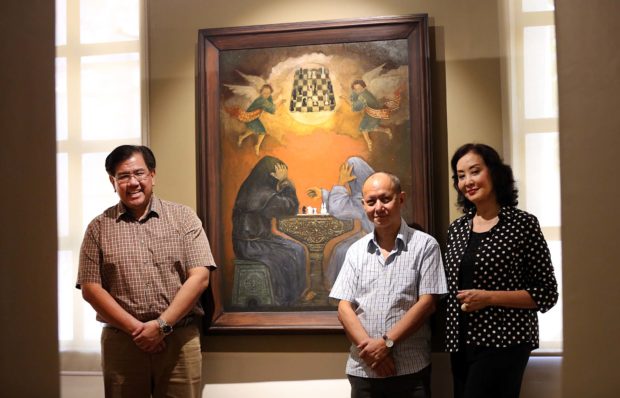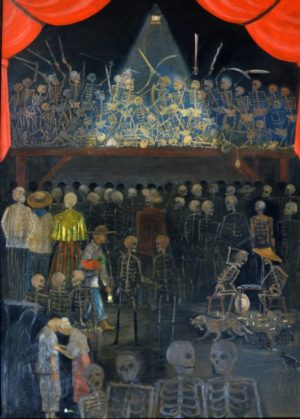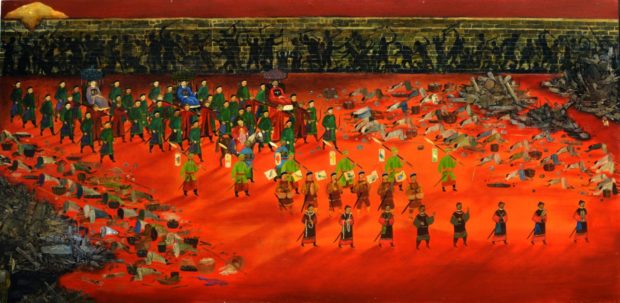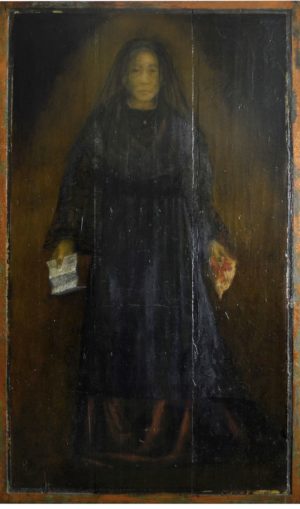“Quadricula” marks the return of Hocus, the singular two-headed creature who took the local art world by storm in April of 2017 with an eponymous six-month exhibit at the National Museum of Fine Arts (NMFA).
In a series of 26 remarkable paintings—six of which are now on permanent display at the museum—Hocus depicted allegorical scenes from an alternate history in which nothing is hidden, everything is revealed.
With the benefit of hindsight drawn from over a century of research and scholarly analysis, coupled with an idiosyncratic approach to history, Hocus lays bare the machinations of the Spanish cross-and-sword approach to subduing the indios.
It is a depiction that rings all the more true for being largely reimagined, a case of art being the lie that makes us realize the truth, to paraphrase Picasso’s famous quote.
Hocus’ work is like nothing else in contemporary Filipino art, and for good reason. “Hocus” is actually an acronym derived from the first syllables of the surnames of the two authors of the series.

“Saul Hofileña Jr. is a lawyer-historian who can neither draw nor paint but is obsessed with Philippine colonial history … Guy Custodio, the painter, is unaware of history although he is a restorer and conservator of ecclesiastical treasures,” writes Gemma Cruz Araneta—their curator and enabler.
“There is a unique synergy between Hofileña and Custodio,” Araneta continues. “The former has nightmarish visions rooted in our colonial history, which the latter painstakingly paints on wood or canvas, in Filipino colonial style.”
The pair has not been idle since their initial salvo: “Quadricula (Hocus II),” their second visionary outpouring, has nearly twice the number of works shown in the first exhibit, each one meticulously composed with an obsessive attention to detail.
Sensitive chord
Taking its name from the grid system of town planning by which the Spanish colonialists imposed their rule and their will on the natives, the current exhibit renews Hocus’ attack on the colonial mind-set that somehow still extends tendrils from the past to influence how modern-day Filipinos think and feel.
“Maybe the paintings struck a sensitive chord because they told our story as a people,” Hofileña writes in his foreword to the catalog that accompanies the current exhibit. “Again, I ask the viewers to ponder on the paintings because each one is a miniature book on our history presented in allegory. Like ‘Hocus,’ the ‘Quadricula’ collection is a visual library ready to be read and studied.”
Indeed, the paintings reward sustained viewing and extended meditation.
Take the striking panorama that is “The Three Mandarins,” Hocus’ take on the complicated history of the Chinese in the Philippines.
It depicts an actual historical event, the arrival of three envoys from the Chinese emperor in Intramuros on May 23, 1603. The envoys are shown being carried by their retainers on sedan chairs, while the Chinese residents of Manila kowtow before them.
Behind this apparent pomp and circumstance, however, etched on the walls of Intramuros—as if by a nuclear explosion—are horrific shadow scenes of an impending massacre. It prefigures the slaughter of 20,000 Chinese by the Spaniards near the Parian gate, aided and abetted by Filipino troops, after an abortive revolt.

“Moros y cristianos” presents the moro-moro, a stage play popularized by the Spaniards depicting battles between Muslims and Christians, as a dance of death, with protagonists and audience alike reduced to skeletons.
The theme is echoed in “The Forever War,” which shows how the Spaniards fanned the flames of enmity between the Christian and Muslim populace.
“El fin del mundo” is Hocus’ apocalyptic vision of the End of Days, taking place during a fluvial parade on the Pasig river, complete with angels, saints, an army of flagellants, and Lucifer himself returned as the Lord of Light.
“What the Friars Taught” is a reversible painting depicting a vision of hell incongruously superimposed on a lush, tropical paradise; and underneath, a parade of Augustinian friars leaving Spain for the colonies.
“This Hocus painting shows how life in these bountiful islands became hell for the natives; without having to go to Hell after death, they were burning in their tropical paradise for the sins the friars said they had committed,” Hofileña writes in his annotation.
Reflections on Rizal
“Reading List 2” and “A las ocho de la manana, 30 Deciembre 1896” are both reflections on Jose Rizal. The former shows the view from a library—the repository of historical truth where Rizal’s vindication awaits—as the firing squad gathers outside in preparation for the hero’s execution. The latter is a portrait of Doña Teodora Alonzo, the hero’s mother, dressed in mourning clothes on the morning of her son’s execution. In one hand she holds the last poem written by her son, in the other a handkerchief stained with his blood.
“She offers it to you,” writes Hofileña. “Will you take it and follow Rizal’s example of love of country, or would you just turn and walk away?”
Most impressive is “Angels Visit the National Museum, at Midnight,” a painting within a painting, which shows three archangels viewing “La Pesadilla” at the National Museum gallery. The painting was the last exhibit’s tour de force, a nightmarish triptych depicting the final battle between good and evil at the Apocalypse, equal parts Esteban Villanueva and Hieronymus Bosch.
“After the ‘La Pesadilla’ triptych was donated to the National Museum of Fine Arts for permanent exhibition, I felt a deep personal loss,” writes Hofileña in his annotation. “It is for this reason that I asked Custodio to duplicate the painting in a smaller scale, with angels visiting it at the NMFA at midnight.
“As the angels contemplated ‘La Pesadilla,’ they were shocked to see what has been happening. The lead angel is angry, his fury obvious even if his back is turned. The sword of a second angel has turned into a flaming blade, which happens whenever angels are overcome with rage. This is a vision that I had in a dream and which I asked Custodio to paint on canvas. Now I have my ‘La Pesadilla’ back.

“People have asked me how in perdition did I conjure those riveting images …,” he writes. “The only explanation I can offer is that every time I read, images of what I am reading form in my mind and these are often overwhelming. I do not know if this happens to other people. But, it is an affliction for which I do not have a name.”
These remarkable visions are then transcribed from one mind to another and on to canvas or wood.
Scriptorium
In an earlier interview with this writer, the partners described their method:
“After seeing and buying some of Guy Custodio’s works, an idea germinated in my mind. What if I ask him to paint what is inside my head? … At first I would email symbols I wanted Custodio to project on canvas … He painted daily, giving life to my images on canvas, with his skillful brush strokes. Before I knew it, I had set up a sort of medieval scriptorium.
“He would tell me the story, and I would start to get ideas,” recalls Custodio, who is steeped in religious art and iconography, having lived and studied restoration in Spain for more than 20 years. “After a while, they just kept coming. What he wanted me to paint, I was able to produce. We worked continuously. Even before I finish one work, he comes up with a new idea. And all his ideas are brilliant.”
Artists don’t like being told what to paint—usually, he adds.
“I was like that, until I found Saul,” he says. “He is relentless in pursuing a theme for a painting. He demands originality, and history. In other words, he wants the truth of the past to be shown graphically in our collaborative work. I have been painting my entire life, but I believe the Hocus paintings will be the achievement of my lifetime.

“Most art is a form of self-expression, so that the artist may, through his well-meaning brushstrokes, define himself and present his soul to his audience,” writes Hofileña in his foreword.
“The ’Quadricula/Hocus’ paintings differ from this mode of self-expression because each work is an expression of how our past has defined our souls conveyed through the medium of oil applied on stretched canvas or ancient wood. Each painting tells our stories as a people, and in the end unravels and reveals who we are and who we will be.
“I beg the viewer of the ‘Hocus’ and ‘Quadricula’ paintings to look at them and to read them as if they were miniature books because that is what they are, fragments of our country’s history presented in allegory.
“In each panel and canvas, the paintings attempt to tell us about our country’s stories, so that we may understand why we are who we are.”
“Quadricula (Hocus II)” is currently on exhibit in Gallery 27 and 28 of the National Art Gallery, National Museum of the Philippines, Manila until March 15, 2020.











































